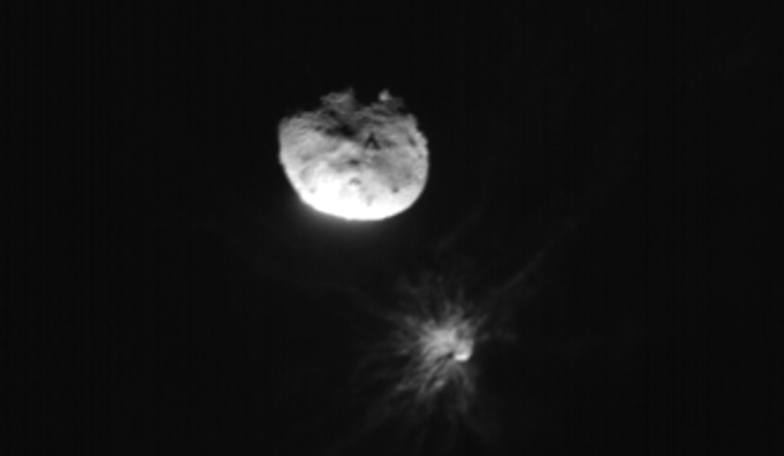
The Italian Space Agency’s (ASI) LICIACube satellite took this image just before its closest approach to the Dimorphos asteroid.
NASA’s Double Asteroid Redirection Test (DART) has been deemed a “first successful step” in demonstrating the viability of a kinetic impact strategy for diverting a near-Earth object, according to findings from five research efforts published March 1 in the journal Nature.
The $324.5 million DART mission was launched from Vandenberg Space Force Base, California, on Nov. 24, 2021. It was equipped with advanced optical navigation, solar arrays and solar electric propulsion assets that enabled it to strike Dimorphos, a 160-m (525-ft.) moonlet of the 780-m-wide asteroid Didymos on Sept. 26, 2022.
While not an impact threat to Earth, the two objects were selected as the DART demonstration target because they could be observed before and after by ground- based telescopes to determine by how much Dimorphos’ 11-hr. 55-min. orbital period was changed by the impact.
The post-impact change in the orbital period for Dimorphos was an initial decrease of 33 min., or 4.6% and much more than the 7 min. initially anticipated, according to the Northern Arizona University-led study, “Orbital Period Change of Dimorphos Due to the Kinetic Impact.”
About 7 million mi. from Earth, Didymos and Dimorphos were separated by 1.18 km (0.73 mi.) ahead of the head-on, 3.8 mi.-per-second impact by the 1,260-lb. (570-kg) DART spacecraft.
“DART’s successful autonomous targeting of a small asteroid with limited prior knowledge is a key first accomplishment on the path to advancing kinetic impactor technology to an operational capability,” according to the Johns Hopkins University Applied Physics Laboratory (APL) Nature study, “Successful Kinetic Impact into an Asteroid for Planetary Defense,” which also emphasizes a need for further development.
“DART’s impact indicates that a precursor reconnaissance mission is not a prerequisite for intercepting a subkilometer asteroid, though the characterization done by a precursor mission would provide valuable information for optimizing, planning and predicting the outcome with greater certainty,” the APL study team concludes. “Kinetic impactor technology for asteroid deflection requires having sufficient warning time—at least several years but preferably decades—to prevent an asteroid impact with the Earth. Nevertheless, this first successful step to demonstrate the viability of kinetic impactor technology for planetary defense builds optimism about humanity’s capacity to protect the Earth from an asteroid threat.”
With enough advance warning and early response, even a small change in the trajectory of a Near Earth Object (NEO) threat could increase the miss distance.
Findings from the wide-ranging research efforts published by Nature point to Dimorphos and Didymos as rubble piles, or gravitational collections of smaller bodies generated by prior asteroid impacts and not unlike the asteroids Itokawa, Bennu and Ryugu visited by recent Japanese and NASA asteroid sample return missions. This suggests a commonality between DART’s targets and potential future Near Earth Object threats to Earth.
Of significant value was post-impact imagery from the Hubble Space Telescope of DART’s impact between two surface boulders on Dimorphos that revealed two debris tails of ejecta that formed within minutes. These results are discussed in the Planetary Science Research-led study, “Ejecta from the DART-produced active asteroid Dimorphos.”
The contour and direction of the tails were influenced by gravitational forces from Didymos as well as solar radiation, according to the Nature-published study. The second ejecta tail came and went between five and 18 days of the strike.
Building on the ejecta observations, the Nature study, “Momentum Transfer from the DART Mission Kinetic Impact on Asteroid Dimorphos,” also led by APL, concluded the ejecta was evidence that Dimorphos’ recoil from the impact significantly enhanced the momentum that led to the change in orbital period.
“Significantly more momentum was transferred to Dimorphos from the escaping impact ejecta than was incident with DART,” the study concludes. “Therefore, the DART kinetic impact was highly effective in deflecting the asteroid Dimorphos.”
While ground observations of Didymos and Dimorphos continue, the European Space Agency’s (ESA) contribution to the DART mission, HERA, is to launch in early 2027 to provide additional close-up reconnaissance of the DART mission’s aftermath.
Meanwhile, no known asteroid larger than 140 m is currently assessed by NASA’s Planetary Coordination Office to have a significant chance of striking Earth over the next century. But Congress has mandated that NASA identify at least 90% of hazardous asteroids of that size or larger—a goal the agency is still striving to achieve. Less than half the estimated 25,000 objects of that size have been discovered.
The omnibus appropriations bill for 2023 signed into law in December provided NASA’s planetary defense budget line with $137.8 million, a total projected to rise to $247.7 million by 2027, according to the agency’s 2023 budget request documentation.
But the budget debate has not been kind to NASA’s planned NEO Surveyor mission, a planetary defense asset. The infrared space observatory is being designed to discover, characterize and track potentially hazardous asteroids and comets that come within 30 million mi. of the Earth’s orbit from the Sun/Earth L-1 Lagrange point about 1 million mi. from the Earth in the direction of the Sun.
In December, the NEO Surveyor mission passed a key milestone in its development, Key Decision Point C, which included a $1.2 billion development cost estimate and a launch date no later than June 2028, or two years later than planned as recently as 2022. As the White House budget proposal for 2023 was presented to Congress in late March 2022, the NEO Surveyor development cost was projected at $830 million through 2027.
